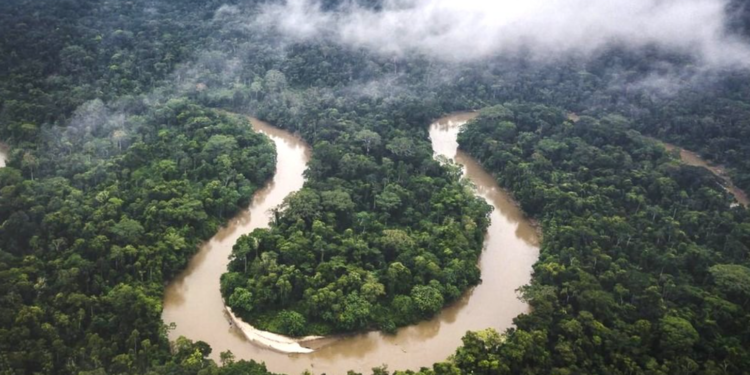Hysteria reigned supreme as recent global mainstream media headlines blamed last year’s drought in the Amazon basin on human-caused climate change. The BBC reported that without human involvement, the drought may have been a once in 1,500 year event. Damian Carrington of the Guardian said it “hit the maximum ‘exceptional’ level on the scientific scale”, whatever that means. Those of a more sceptical persuasion might note that the scares arose from computer models funded by the green billionaire investor Jeremy Grantham. In fact, rainfall in the area has shown little cyclical deviation across nearly 300 years, severe droughts are common in the basin, particularly in El Niño years, and temperatures in Brazil have risen by only 0.6°C since 1900 – considerably less than rises claimed for the northern hemisphere.
The scares emanated from World Weather Attribution (WWA), a green activist unit run out of the Grantham Institute at Imperial College. The take-out figure, reproduced around the media, was that the event was 30 times more likely to happen due to what the Guardian called “global heating”. The climate crisis is “super-charging” extreme weather across the planet, informs a clearly very disturbed Carrington, and the Amazon rainforest is already thought to be close to a “tipping point” into a drier state.
Calm down. Not according to work published last September by two geo-scientists in the American Meteorological Society’s Journal of Climate. The graph below tracks rainfall going back to 1760 and shows a remarkably consistent cyclical pattern up to present times. The graph also shows that severe droughts were not uncommon in the historical past – events that are also recorded in copious writings from the time.

The scientists used proxy evidence provided by tree rings to calculate rainfall and found that recent high and low flow anomalies on the Amazon river “may not have exceeded the natural variability of precipitation and stream-flow during the 19th century”. Recent river-level extremes may have been equalled or possibly exceeded in the pre-industrial 1800s, they added.
In its way the WWA fills a gap in the pseudoscientific market. Much to the irritation of activists, the UN Intergovernmental Panel on Climate Change has largely refused to be drawn on any increasing signal in natural disasters such as droughts, hurricanes and wildfires. Using what it claims to be “peer-reviewed” methods, WWA computer models first simulate a climate with no human involvement that does not exist, and then compare it with another simulation that is supposed to reflect the involvement of humans burning hydrocarbons. Any weather event at a local level that is magnified in the second scenario – magic words can be applied at this point – is said to be due to human-caused climate change. “I can think of no other area of research where the relaxing of rigour and standards has been encouraged by researchers in order to generate claims more friendly to headlines, political advocacy and even lawsuits,” is the verdict of the distinguished science commentator Roger Pielke Jr.
The WWA accepts the influence of a strong El Niño causing drought in the Amazon last year, but said its study showed climate change was the main driver of the event, “through its influence on higher temperatures”. It is a little warmer in Brazil than 120 years ago as the planet has naturally bounced back from the Little Ice Age. But the tropics generally show much less warming than parts of the northern hemisphere.

The above temperature graph for Brazil has been published by the World Bank and it shows a rise from 1901 to 2022 of just 0.6°C. In fact on a five-year smoothing trend it displays a near 0.3°C fall between 2017 and 2022.
The billionaire-funded WWA and its faithful poodle press pack are clearly attempting to fill global populations with alarm about a collapsing climate and the need for a supra-national, collectivist Net Zero solution. WWA co-founder and regular BBC contributor Dr. Friederike Otto is quite clear about the political message being promoted. She noted that it was “very worrying” that human-caused climate change was the driver of the devastating drought in the Amazon last year. “Our choices in the battle against climate change remain the same in 2024 – continue to destroy lives and livelihoods by burning fossil fuels, or secure a healthy, liveable future by rapidly replacing them with clean renewable energy.” But whatever the political agenda, the product of attribution models is not scientific proof. In fact they prove nothing since they fail the most important principle of the scientific process – they cannot be tested and shown to be either true or false. In the end they are just opinions, and it is to the increasing discredit of much mainstream media that they are treated as anything else.
The Ottos of this world might think they can stop the climate changing, but back on the real planet the Amazon seems to be getting along just fine. Deforestation is a real problem but that has nothing to do with a changing climate, and is solvable at a political level. Improving the standard of living for people living in the Amazon region by encouraging more hydrocarbon use might help. Last week the Daily Sceptic reported on the accelerated rate of global ‘greening’ caused by higher levels of carbon dioxide in the atmosphere over the last two decades. This growth can be seen in the map below.

The entire Amazon region has not shown as much leaf growth as India, Europe and eastern equatorial Africa. It has yet to hit the “maximum exceptional level on the scientific scale”, as the Guardian probably wouldn’t note, but it hardly suggests an area in vegetative decline.
Chris Morrison is the Daily Sceptic’s Environment Editor.













To join in with the discussion please make a donation to The Daily Sceptic.
Profanity and abuse will be removed and may lead to a permanent ban.